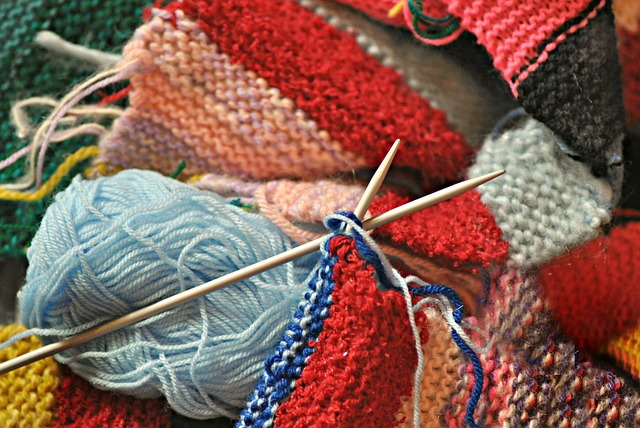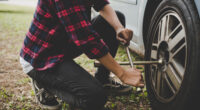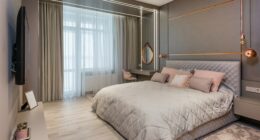Weaving intertwines perpendicular threads to create fabric, while knitting uses a series of interlocking loops formed with a single yarn.
TL;DR Weaving Vs. Knitting
Weaving involves interlacing vertical and horizontal threads on a loom to form a cohesive fabric. It is characterized by its precise structure and the ability to create complex patterns.
Knitting uses needles to loop yarns together, resulting in a more flexible and stretchy fabric. Knitting is a timeless craft that allows individuals to express their creativity while creating beautiful and functional items with just some yarn and needles
What is Weaving?

Weaving is a textile production method that involves interlacing two sets of yarn or threads—warp and weft—at right angles to create fabric. The vertical threads (warp) are held taut on a loom, and the horizontal threads (weft) are woven through, forming the fabric.
This process creates various patterns and textures, allowing for the production of diverse textiles. Weavers use different techniques, looms, and materials, ranging from traditional hand weaving to modern mechanized methods.
Weaving has a rich history, with cultural significance worldwide, and its products include a wide array of fabrics, rugs, and tapestries.
What is Knitting?

Knitting is a textile craft where yarn is manipulated to create a fabric by interlocking loops. Using needles, stitches are formed by pulling new loops through existing ones. The two main types are hand knitting and machine knitting.
Hand-knitting allows for intricate designs, while machines expedite the process. Knitted fabrics can vary in texture, thickness, and patterns. This versatile craft produces garments, accessories, and textiles.
Knitting is both a practical skill and a creative outlet, with a rich history spanning various cultures. Its popularity endures, blending tradition with contemporary fashion and artistic expression.
Weaving Vs. Knitting – Key differences
| Feature | Weaving | Knitting |
|---|---|---|
| Technique | Interlacing warp and weft threads perpendicularly | Interlocking loops of yarn with needles |
| Tool | Loom | Needles |
| Stitch Formation | Interlacing threads | Creating loops with needles |
| Fabric Structure | Typically more structured and stable | Often more stretchy and flexible |
| Fabric Appearance | Often features clear patterns and designs | Patterns may include intricate textures |
| Fabric Use | Carpets, rugs, tapestries, structured fabrics | Garments, accessories, softer fabrics |
| Skill Level | Requires skill in setting up and operating a loom | Requires skill in various stitch techniques |
| Production Efficiency | Slower for intricate patterns | Can be faster, especially with knitting machines |
The Process of Weaving
The process of weaving involves interlacing two sets of yarn or threads, known as the warp and the weft, to create fabric. Here is a general overview of the weaving process:
- Warping: Long threads, called the warp, are stretched tightly on a frame or loom in a parallel arrangement. These threads run vertically.
- Sizing: The warp threads are often treated with a sizing or starch to strengthen them and make them more resistant to abrasion.
- Threading: The warp threads are threaded through heddles, which are wire or string loops on the loom that can be raised or lowered.
- Tying the Warp: The warp threads are tied to the loom’s front and back beams to create tension.
- Shedding: The heddles are manipulated to create an opening, known as the shed, through which the weft thread will be passed.
- Weaving: The weft thread, which runs horizontally, is passed through the shed using a shuttle or other device. The weft is beaten down to tighten the weave.
- Repeating: Steps 5 and 6 are repeated, alternating the raising and lowering of the heddles to create different sheds, and the weft is woven across.
- Tensioning: Periodically, the woven fabric is rolled onto the cloth beam to maintain tension and allow for additional weaving.
- Finishing: After reaching the desired length, the woven fabric is cut from the loom. Additional processes such as washing, dyeing, and finishing may follow.
Weaving can be done by hand on traditional looms or by machine on power looms. Different weaving techniques, patterns, and types of looms contribute to the diversity of woven fabrics produced for various purposes.
The Process of Knitting
The process of knitting involves creating fabric by interlocking loops of yarn using needles. Here is a general overview of the knitting process:
Casting On: The process begins with casting on, where a set number of stitches are created on one of the knitting needles. This establishes the foundation for the project.
Knitting Stitches: Using one or more needles, the knitter inserts the second needle into the first stitch and loops the yarn over the needle, pulling a new loop through the existing stitch. This process is repeated across the row.
Purling: Purl stitches are created by inserting the needle from right to left through the back of the stitch, bringing the yarn forward, and pulling a loop through. Combining knit and purl stitches creates various textures and patterns.
Continuing Rows: Rows are continued by knitting or purling across the stitches, turning the work at the end of each row.
Shaping: To create different shapes, such as increasing for sleeves or decreasing for a neckline, stitches are added or subtracted within a row.
Binding Off: Once the desired length is reached, the project is finished by binding off. Stitches are knit or purled and then lifted over each other, securing the final row.
Blocking: The finished piece may be blocked by wetting it and shaping it to the correct dimensions. This helps even out stitches and enhances the final appearance.
Finishing: Loose ends are woven in, and any additional components, such as buttons or seams, are added to complete the project.
Knitting can be done by hand with various techniques or by machine for more rapid production. The choice of yarn, needle size, and stitch pattern contributes to the final appearance and characteristics of the knitted fabric.
Image Credits
Featured Image By – 👀 Mabel Amber, who will one day from Pixabay
Image 1 By – 💚🌺💚Nowaja💚🌺💚 from Pixabay
Image 2 By – jwdenson from Pixabay








